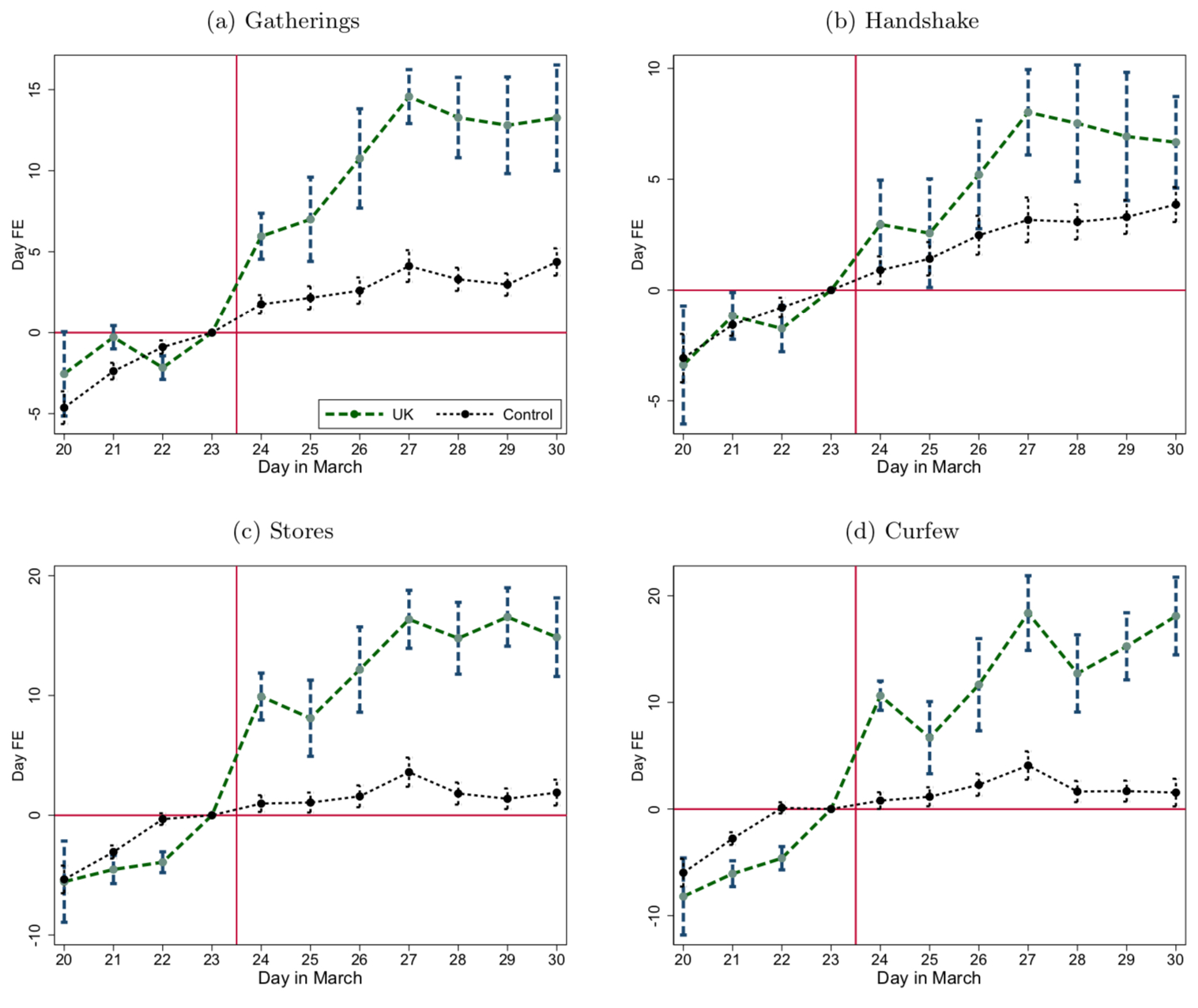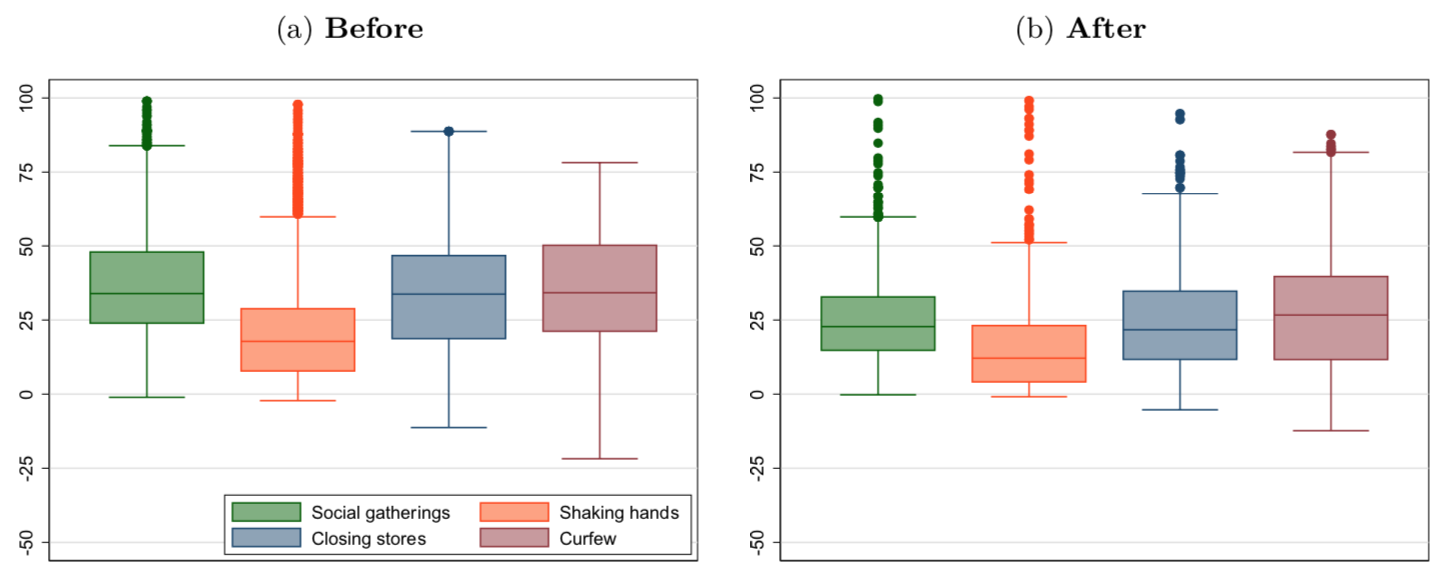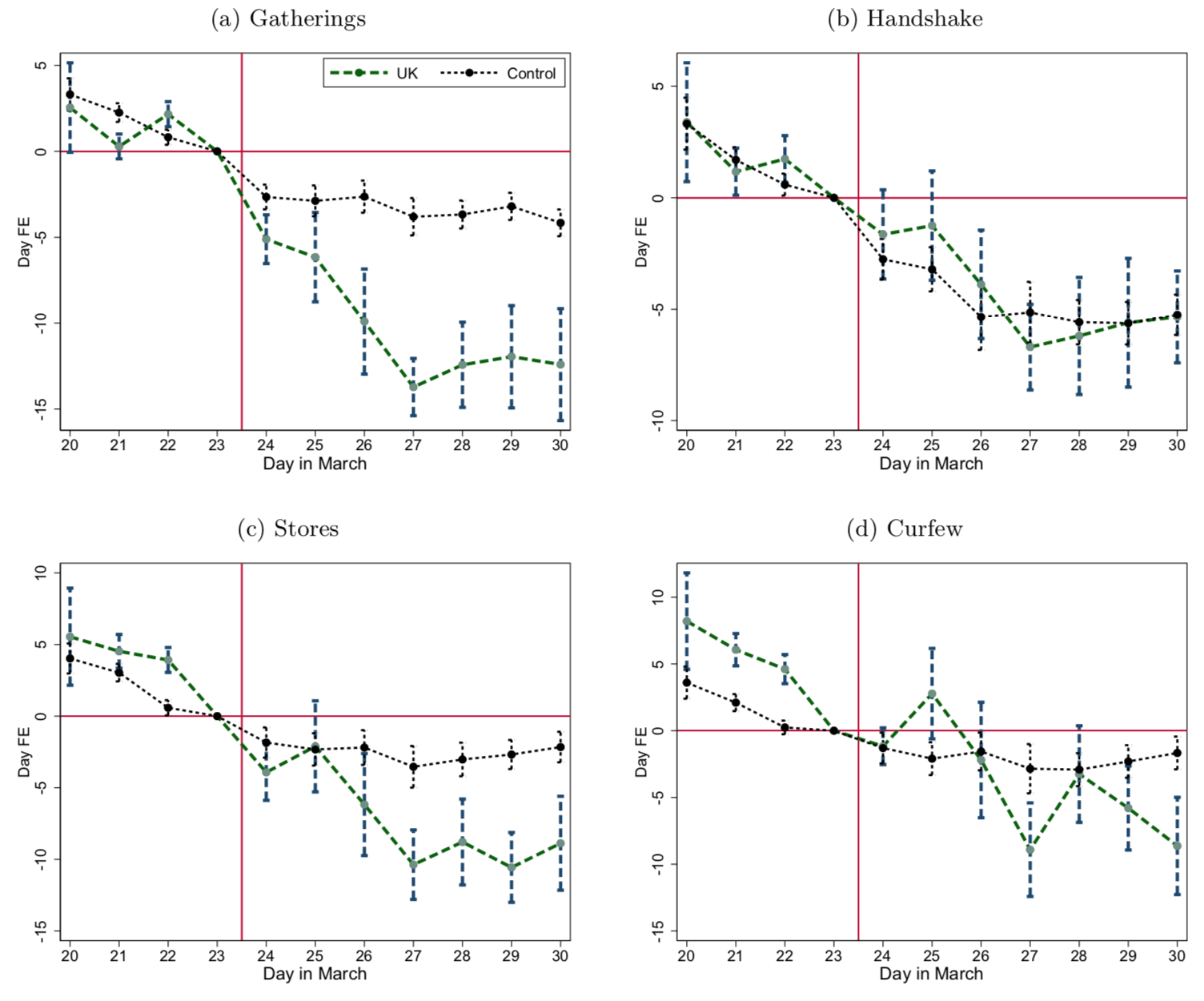In order to promote social distancing to contain the spread of Covid-19, governments introduced strict regulations. This column uses interviews from before the 23 March announcement of a nationwide UK lockdown and after the announcement to show that the introduction of the new laws affected the perception of social norms regarding the various containment measures – that is, what people thought the prevalent norms were. This appears to have been the result of fewer misperceptions about the social norms after the introduction of the laws, rather than actual changes in the social norms.
In large groups, cooperation between individuals typically cannot solely rely on their good will and is often ensured by the means of laws. For instance, in order to promote social distancing in the context of the current pandemic, governments have introduced strict regulations and relied extensively on the use of fines. Under what circumstances should we expect laws to successfully sustain cooperation? This is a long-standing question in social sciences, where different approaches have emerged. While the traditional law and economics approach (Becker 1968) emphasises the effects of incentives in the form of sanctions, a recent literature in behavioural science and legal studies reminds us that non-material factors and social norms play a central role in explaining individual compliance with laws (Zamir and Teichman 2018).
Laws may in particular have the ‘expressive function’ of inducing cooperation by changing the perceived social norm – i.e. what people think the prevalent norm is. In Galbiati et al. (2020), we take advantage of the lockdown measures introduced to face the Covid-19 pandemic to provide causal evidence that laws do indeed affect the perception of social norms. We focus on the case of UK Prime Minister Boris Johnson’s announcement of a nationwide lockdown on the evening of 23 March 2020. This setting has several key features that we can exploit to investigate the causal effect of laws on perceptions of the social norm. First, the implementation of the law came as a relative surprise, representing a sharp change in the strategy of a government that had previously signalled strong reserves regarding total lockdowns. Second, the law was far reaching, including several different policies – such as lockdown and store closures – that had typically been implemented more gradually in other countries. Based on mobility data in the UK, we show that the law had an immediate impact on mobility – for instance, reducing trips to parks by 30%.
Relying on survey data (Fetzer et al. 2020), we study the change in perceived norms induced by this shock to the UK legal rules. The data contain information on perceived social norms (i.e. ones’ beliefs about what others consider appropriate) regarding four types of Covid-related measures: the avoidance of social gatherings, stay-at-home measures, store closures, and general curfews. We focus on the daily responses of individuals that were interviewed before the announcement of the lockdown on 23 March with those that were interviewed after the announcement. Trends in the perception of the social norm are controlled for by comparing this change over time to the evolution on the same days for respondents living in a set of control countries. Figure 1 presents the results of the corresponding event study analysis. The figure shows that the lockdown announcement significantly increased the likelihood that individuals believe their compatriots view staying at home, closing stores, and not participating in social gatherings positively. The effect is very sizable, representing for instance a 15 percentage point increase in the belief that other people think that stay-at-home measures should be followed. The effect is strongest for the implementation of a general curfew and the closure of stores; it is weaker for social gatherings and positive but only small and, for the most part, insignificant for the ‘no handshaking’ policy.
Figure 1 Time pattern of perceived social norms in the UK and the control group

Based on the framework introduced by Benabou and Tirole (2011), there are two main explanations for such a change in the perception of social norms: on one hand, social norms themselves might have shifted, since the law modified incentives; on the other hand, the law could be used to learn about the prevalent social norm if there is some misperception about it. Notably, the two explanations differ in whether the social norm actually changes. To disentangle the two, we build a measure of actual social norms by exploiting an additional question of the survey asking respondents about their personal norm (i.e. whether they think people should comply with the policy). If the information about the prevalent social norm is perfect, the average over the entire population of the personal norms should be equal to the average perception of the social norm.
Figure 2 Before and after comparison of misperceptions in the UK

The left panel of Figure 2 shows that before 23 March, the perceptions of the social norm were significantly below the norm itself for most dimensions, except for handshaking where the discrepancy was much lower. The right panel shows that after 23 March, this misperception gap drops sharply. To investigate whether this change in misperception can be attributed to the laws passed at the time of the lockdown decision in the UK, Figure 3 replicates the event study on the misperception measure. The figure confirms a strong effect of the law on misperception. This set of results suggests that the most plausible channel is that the law changed the perceptions of the social norm without actually changing the norm itself (which is confirmed by further statistical analysis of the effect of the lockdown on the average personal norms). In fact, for handshaking – the dimension where misperceptions were initially the lowest – the law had virtually no effect on the perceptions of the social norm.
Figure 3 Time pattern of misperceptions in the UK and the control group

From a policy perspective, these results imply that the design of laws should take into account their effect on the perceived norm: people will not only react to the newly implemented material incentives, but will also internalise the norm expressed by the law. While our results suggest an important channel for such an interaction is the informational content of the law about the prevalent norm, it is worth stressing that the UK had several features that favoured this informational channel. First, the population was initially pessimistic about the prevalent norm, as indicated by the large misperception gap before 23 March, leaving room for new information to affect beliefs. Second, the enforcement of the law was weaker compared to other countries, decreasing the potential for a direct impact on social norms themselves.
References
Benabou, R and J Tirole (2011), "Laws and Norms", NBER Working Paper 17579.
Becker, G (1968), "Crime and Punishment: An Economic Approach", The Journal of Political Economy 76: 169-217.
Fetzer, T, M Witte, L Hensel et al. (2020), "Perceptions of an Insufficient Government Response at the Onset of the COVID-19 Pandemic are Associated with Lower Mental Well-Being", PsyArXiv, 16 April.
Galbiati, R, E Henry, N Jacquemet and M Lobeck (2020), "How Laws Affect the Perception of Norms: Empirical Evidence from the Lockdown", CEPR Discussion Paper 15119.
McAdams, R H (2017), The Expressive Powers of Law: Theories and Limits, Harvard University Press.
Zamir, E and D Teichman (2018), Behavioral Law and Economics, Oxford University Press.
"social" - Google News
October 24, 2020 at 07:01AM
https://ift.tt/35uktEN
Laws and perceptions of social norms: Lessons from the lockdown | VOX, CEPR Policy Portal - voxeu.org
"social" - Google News
https://ift.tt/38fmaXp
https://ift.tt/2WhuDnP
Bagikan Berita Ini














0 Response to "Laws and perceptions of social norms: Lessons from the lockdown | VOX, CEPR Policy Portal - voxeu.org"
Post a Comment